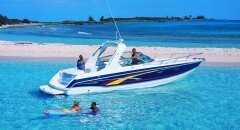Walk on Water
My journey as a barefooter began in the mid-1970s, when I tried to step off a ski onto my bare feet. In those days, there were no barefoot coaches. No wonder I needed a whole summer to finally master the step-off.
  Â
So, in addition to a good teacher, what are the keys to successful footing? Not much more than a solid understanding of basic body positioning, a little bit of gear â and practice, practice, practice.
Starting on the Right Foot
There are several techniques to get up on the water while barefooting. Besides just stepping off a ski mid-run, you can do a deep water start, which consists of coming out of the water on your back with the handle at your waist and your feet in front of you on or next to the line. Once youâre on top of the water: sit up, plant your feet, and stand up into a chair position.
Another way of getting onto your feet is by sitting on a kneeboard with legs and feet straddling the board. Once the kneeboard is planing on the water, plant your feet and have the driver increase speed. Stand up, the kneeboard will slide behind and â voilà ! â youâre footing.
These techniques can be learned behind a boat, but youâll have a much easier time â and may even get the hang of it after only a day or two â if you can learn on a boom.
Learning on a boom is the fastest, easiest way to become a barefooter.
Bring on the Boom
The advantage to the boom: Instead of being by yourself 75 feet behind the boat, you hold directly onto the boom, just feet from the driver. With the boomâs firm support, you can learn to step off, do a deepwater start, or a kneeboard start just like you would behind the boat, but with added confidence and stability. The solid upward pull of the boom provides a lot of security to the footer. Whatâs more, the water is smooth next to the boat, and whoever is teaching you can give you instructions from a few feet away, rather than resorting to shouting and wild gesturing.
Strike the Pose
Body position is critically important to your success. You want legs parallel to each other with ankles and knees bent while your back is vertical to the water. Itâs like sitting in a high chair. Arms should be slightly bent and relaxed.
A crucial concept is that your feet should glide over the water. But almost everyone at first tends to push and plow the feet in front of the knees. Not a good position. Plowing your feet in front of you puts a lot of stress on your arms and hands, tiring them quickly.
The spray from your feet tells the story. When your feet are pushing and plowing, they throw a lot of spray. When the spray is minimal, you can see the feet. This means the body position is effectively supporting your weight and your feet are gliding. Soon youâll be learning tricks.
with 5 feet of line attached to the boom. At this point you still have the benefit of the upward pull of the boom and the smooth water, but now thereâs some sense of the way the handle and line feels behind the boat.
When you are ready to foot behind the boat, you donât have to go directly to the tow pylon. If your boat has a tower, use it. Towers are great for getting more air for wakeboard riders, but the high-towing point also makes all starts and tricks easier.
A good guide for figuring out barefoot boat speed is to divide your weight by 10 and then add 20. If you weigh 160 pounds, for example, then 36 mph should be the right speed for you. But being pulled from the tower makes it feel as though you instantly lost 20 or 30 pounds. Accordingly, the boat speed can be reduced by 2 or 3 mph.
Use a no-stretch line like polyethylene or a Spectra line that is at least 70 feet long. Depending on your wake, you may want to experiment with 10-foot extensions, making a line of 80 or 90 feet.
Gear Up
A right-sized barefoot suit fits you specifically; itâs not one that youâll grow into or share with others. The barefoot suit must fit so tight so that hardly any water enters. The less water weight, the easier the starts. And once you are up, youâll feel lighter.
One thing is for sure: Itâs not 1976. Thanks to sophisticated coaching, instructional barefoot videos, and well-tuned training aids and equipment, any water-skier can learn to foot in no time.
Zenon Bilas is a seven-time U.S. Barefoot Water-ski champion. With his camera and notebook, he covers the boating and water-skiing scene worldwide.
Content provided courtesy of Cabin Life.
Â




